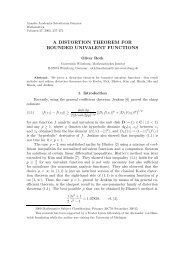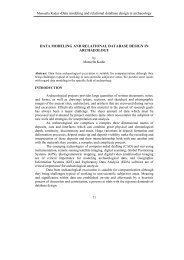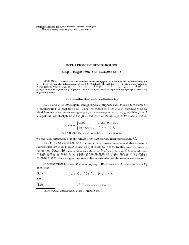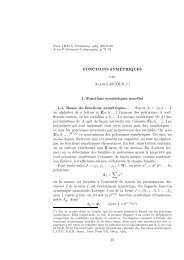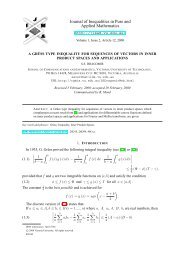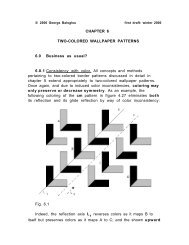SUPERNOMIAL COEFFICIENTS, BAILEY'S LEMMA AND ROGERS ...
SUPERNOMIAL COEFFICIENTS, BAILEY'S LEMMA AND ROGERS ...
SUPERNOMIAL COEFFICIENTS, BAILEY'S LEMMA AND ROGERS ...
You also want an ePaper? Increase the reach of your titles
YUMPU automatically turns print PDFs into web optimized ePapers that Google loves.
<strong>SUPERNOMIAL</strong> <strong>COEFFICIENTS</strong>, BAILEY’S <strong>LEMMA</strong> <strong>AND</strong><strong>ROGERS</strong>–RAMANUJAN-TYPE IDENTITIES.A SURVEY OF RESULTS <strong>AND</strong> OPEN PROBLEMSS. OLE WARNAARAbstract. An elementary introduction to the recently introduced A 2 Baileylemma for supernomial coefficients is presented. As illustration, some A 2q-series identities are (re)derived which are natural analogues of the classical(A 1 ) Rogers–Ramanujan identities and their generalizations of Andrewsand Bressoud. The intimately related, but unsolved problems of supernomialinversion, A n−1 and higher level extensions are also discussed. Thisyields new results and conjectures involving A n−1 basic hypergeometric series,string functions and cylindric partitions.1. IntroductionThe purpose of this paper is twofold. Firstly, it intends to provide an easyintroduction to recent results by Andrews, Schilling and the author [9] concerningan A 2 Bailey lemma for supernomial coefficients. The fact that thetheorems of [9] have led to the discovery of A 2 analogues of the famous Rogers–Ramanujan identities, (hopefully) justifies such an introduction. Secondly, wehope to attract some interest in the numerous unsolved problems directly relatedto the results of ref. [9].In the first part of this paper, comprising of sections 2–4, we review theA 1 Bailey lemma and its A 2 supernomial generalization, and show how thisprovides a natural framework for proving and deriving identities of the Rogers–Ramanujan type. To make this part of the paper as accessible as possible wehave omitted all proofs and have removed all the usual Bailey miscellanea.Also, we have chosen to cover only the simplest possible cases that can beextracted from the general Bailey machinery (see e.g., [10, 5, 6, 30, 1, 12, 31, 9]).In the second part of the paper (sections 5-7) we discuss various questionsthat have arisen in relation to our A 2 Bailey lemma. Most importantly thereis the problem of generalizing the results of [9] to A n−1 , but also questionsconcerning supernomial inversion, higher-level Bailey lemmas and some relatedissues will be surveyed.1991 Mathematics Subject Classification. Primary 05A30, 05A19; Secondary 33D90,33D15, 11P82.Key words and phrases. Rogers–Ramanujan identities, supernomial coefficients, Bailey’slemma.1
2 S. O. WARNAARWe should remark here that this paper does not in any way discuss the A n−1Bailey lemma of Milne and Lilly [28, 29], nor the A n−1 Rogers–Ramanujanidentities of Milne [26, 27]. It is our current believe that the A 2 Bailey lemmafor supernomials and the A 2 case of Milne and Lilly’s lemma are generalizationsof the classical A 1 Bailey lemma, which, in a sense, are orthogonal. Also theA 2 Rogers–Ramanujan identity of this paper appears to be unrelated to theA 2 case of Milne’s A n−1 Rogers–Ramanujan identity.2. A 1 Rogers–Ramanujan-type identitiesThe Gaussian polynomial or q-binomial coefficient is defined as⎧[ n⎨ (q) nfor 0 ≤ m ≤ n= (q) m (q) n−mm]⎩0 otherwise,where (a; q) ∞ = (a) ∞ = ∏ ∞k=0 (1 − aqk ) and(a; q) n = (a) n =(a) ∞(aq n ) ∞, n ∈ Z.In particular, (q) 0 = 1, (q) n = (1 − q) . . . (1 − q n ) and 1/(q) −n = 0 for n ≥ 1.We will often use a shifted and normalized q-binomial coefficient, defined as⎧S(L, k) = 1 [ ] 2L⎨ 1for − L ≤ k ≤ L(2.1)= (q) L−k (q) L+k(q) 2L L − k ⎩0 otherwise.By the q-Chu–Vandermonde summation (equation (3.3.10) of [3]), it followsthat the modified q-binomial satisfies the following “invariance property”(equation (13) of [31] with c k = δ k,r ) ,(2.2)M∑L=0q L2 S(L, r)(q) M−L= q r2 S(M, r).That is, the modified q-binomial is (up to an overall factor) invariant undermultiplication by q L2 /(q) M−L followed by a sum over L. It is this property ofthe q-binomial that we shall try to generalize to other q-functions.First, however, let us demonstrate the effectiveness of the result (2.2) inderiving identities of the Rogers–Ramanujan type. To obtain identities for oddmoduli our starting point is the following specialization of the the q-binomialformula (equation (II.4) of [15]),(2.3)L∑(−1) r q (r 2) S(L, r) = δL,0 ,r=−L
<strong>SUPERNOMIAL</strong> <strong>COEFFICIENTS</strong> . . . 3with ( r2)= r(r − 1)/2 for r ∈ Z. Applying (2.2) k times (that is, multiplying(2.3) by q L2 /(q) M−L , summing over L using (2.2) and replacing M by L, anditerating this k times) yieldsL∑∑(−1) r qq (r 2)+kr N 2 1 2+···+N k−12S(L, r) =,(q) L−N1 (q) n1 · · · (q) nk−1r=−Ln 1 ,...,n k−1 ≥0where N j = n j + · · · + n k−1 . If we let L tend to infinity and use Jacobi’s tripleproduct identity∞∑(2.4)(−z) j q (j 2) = (z, q/z, q)∞ ,j=−∞where (a 1 , . . . , a k ; q) n = (a 1 , . . . , a k ) n = (a 1 ) n . . . (a k ) n , the following result isobtained.Theorem 2.1. For k ≥ 2, |q| < 1, and N j = n j + · · · + n k−1 ,(2.5)∑n 1 ,...,n k−1 ≥0n≥0q N 2 1 +···+N 2 k−1(q) n1 · · · (q) nk−1= (qk , q k+1 , q 2k+1 ; q 2k+1 ) ∞(q) ∞.For k = 2 this is the (first) Rogers–Ramanujan identity [32, 33, 38, 34]∑ q∞∏n2(2.6)1=(q) n (1 − q 5n+1 )(1 − q 5n+4 ) .n=0For general k equation (2.5) is (a particular case) of Andrews’ analytic counterpart[2] of Gordon’s partition theorem [18].To obtain a similar result for even moduli, we start with the simple identity(equation (40) of [30]),L∑(−1) r 1(2.7)q r2 S(L, r) = .(q 2 ; q 2 ) Lr=−LApplying (2.2) k − 1 times yieldsL∑∑(−1) r q kr2 S(L, r) =r=−Ln 1 ,...,n k−1 ≥0q N 2 1 +···+N 2 k−1(q) L−N1 (q) n1 · · · (q) nk−2 (q 2 ; q 2 ) nk−1.When L tends to infinity one can again apply the triple product (2.4), resultingin our next theorem.Theorem 2.2. For k ≥ 2, |q| < 1, and N j = n j + · · · + n k−1 ,(2.8)∑n 1 ,...,n k−1 ≥0q N 2 1 +···+N 2 k−1(q) n1 · · · (q) nk−2 (q 2 ; q 2 ) nk−1= (qk , q k , q 2k ; q 2k ) ∞(q) ∞
4 S. O. WARNAARFor k = 2 this identity is due to Euler. For general k the above result wasfirst obtained by Bressoud [11].3. Supernomial coefficientsIn this section we introduce A n−1 generalizations of the q-binomial coefficientsand show how, in the case of A 2 , the invariance property (2.2) can begeneralized. This is then used to derive A 2 Rogers–Ramanujan-type identitiesfor all moduli. First, however, to serve as a guide for subsequent generalizations,some of the equations of the previous section are rewritten in manifestA 1 form.3.1. A 1 again. As is often convenient when dealing with root systems of typeA n−1 , we introduce n variables k 1 , . . . , k n constrained to the hyperplane k 1 +· · · + k n = 0. We denote k = (k 1 , . . . , k n ), ρ = (1, . . . , n), and for arbitraryv ∈ Z p we set |v| = ∑ pi=1 v i, so that, in particular, |k| = 0. The Cartan matrixof A n−1 will be denoted by C, i.e., C i,j = 2δ i,j − δ |i−j|,1 , i, j = 1, . . . , n − 1.Now assume n = 2. Then k = (k 1 , k 2 ) = (k 1 , −k 1 ), ρ = (1, 2) and C = (2).We can then rewrite equation (2.1) in vector notation as⎧⎨ 1for k 1 , k 2 ≤ L 1(3.1) S(L, k) = (q) L1 −k 1(q) L1 −k 2⎩0 otherwise.where L = (L 1 ).Similarly, the invariance property (2.2) becomes(3.2)M∑L=0q 1 2 LCL S(L, k)(q) M−L= q 1 2 (k2 1 +k2 2 ) S(M, k),where, generally, for v, w ∈ Z p , vAv = ∑ pi,j=1 v iA i,j v j , (a) v = (a) v1 . . . (a) vpand ∑ wv=0 = ∑ w 1v 1 =0 · · · ∑w pv . p=0The equations (2.3) and (2.7) that served as input in the derivation of theRogers–Ramanujan-type identities become in the new notation∑ ∑ɛ(σ)q ∑ 2i=1 (k i−σ i )k(3.3)iS(L, 2k − σ + ρ) = δ L1 ,0.σ∈S 2and(3.4)|k|=0|k|=0∑ ∑ɛ(σ)q 1 ∑ 22 i=1 (2k i−σ i +i) 2 S(L, 2k − σ + ρ) =σ∈S 21(q 2 ; q 2 ) L1,where S n is the permutation group on 1, 2, . . . , n and ɛ(σ) is the sign of thepermutation σ.
6 S. O. WARNAARpolynomials P λ in n variables [24], thanks toe λ (x 1 , . . . , x n ) = ∑ ( ∑)K ηλ K η ′ µ(q) P µ (x 1 , . . . , x n ; q).µ ⊢|λ| η ⊢|λ|In [37] the supernomials were introduced from a combinatorial point of view asthe generating functions of inhomogeneous lattice paths, generalizing the factthat the multinomial coefficient (3.5) is the major index generating functionon words over the alphabet {1, . . . , n}.If we now restrict (3.6) to n = 3, and set ν (1) = λ 1 , ν (2) = (λ 1 + m, λ 2 − m)and ν (3) = (L 1 + L 2 , L 2 ) we get[ L=λ]∑ m[ ][λ1 − λ 2 + 2mmL 1λ 1 − L 2 + m][L2λ 2 − mfor λ 1 +λ 2 +λ 3 = L 1 +2L 2 and zero otherwise. The following, more symmetric,representation may be derived using the q-Chu–Vandermonde sum,[ L=λ]∑ q r 1r 23(q) L1 (q) L2,(q)r r1 (q) r2 (q) r3 (q) r12 (q) r13 (q) r23where the summation over r denotes a sum over r 1 , . . . , r 23 such that]andr 1 + r 12 + r 13 = λ 1 , r 2 + r 12 + r 23 = λ 2 , r 3 + r 13 + r 23 = λ 3r 1 + r 2 + r 3 = L 1 , r 12 + r 13 + r 23 = L 2 .3.3. An A 2 invariance property. We now show how, in the case of A 2 , thesupernomials may be used the generalize the q-binomial invariance (3.2). Thefirst step is, of course, to again shift and normalize the supernomials, and forgeneral rank we define in analogy with (2.1) and (3.1),S(L, k) = 1 []CL(3.7)(q) CL L n−1 (1 n ) − kwith L ∈ Z n−1+ and k ∈ Z n such that |k| = 0. Observe that ∑ ni=1 (L n−1 − k i ) =nL n−1 = ∑ n−1a=1 a(CL) a so that the condition |λ| = |ν (n) | in definition (3.1) isautomatically satisfied.Considering A 2 again, we would like to show that the following invarianceproperty holds (compare with (3.2))(3.8)M∑L=0q 1 2 LCL S(L, k)(q) M−L= q 1 2 (k2 1 +k2 2 +k2 3 ) S(M, k).The analogy with A 1 breaks down, however, and a somewhat unexpected (tous at least) result arises as follows (theorem 4.3 of [9] with a = 1).
<strong>SUPERNOMIAL</strong> <strong>COEFFICIENTS</strong> . . . 7Theorem 3.2. Let L, M ∈ Z 2 +, k ∈ Z 3 , such that |k| = 0 and let S(L, k) bethe A 2 supernomial defined in (3.7) and T (L, k) be defined in (3.11) below.Then(3.9)and(3.10)M∑L=0q 1 2 LCL S(L, k)(q) M−L= q 1 2 (k2 1 +k2 2 +k2 3 ) (q) |M| T (M, k)M∑L=0q 1 2 LCL T (L, k)(q) M−L= q 1 2 (k2 1 +k2 2 +k2 3 ) T (M, k).So we do find an invariance property, but only after summing the supernomialS to a new q-function T , given in the following definition.Definition 3.3. For L ∈ Z 2 + and k ∈ Z 3 such that |k| = 0,(3.11)T (L, k) =1(q) 2 L 1 +L 23∏i=1[ ]L1 + L 2.L 1 + k iThe fact that (3.8) is not correct and has to be replaced by the non-trivialtheorem 3.2 is the main obstacle for treating the general rank case. Indeed,for arbitrary A n−1 we find that (L, M ∈ Z n−1+ , k ∈ Z n such that |k| = 0)M∑L=0q 1 2 LCL S(L, k)(q) M−L= q 1 2 (k2 1 +···+k2 n ) S(M, k)is invalid for any n ≥ 3. How to correct this, in a way similar to Theorem 3.2,is unclear to us at present. A partial result on A n−1 is given in proposition 6.1of section 6.4. A 2 Rogers–Ramanujan-type identitiesWe now use the two summations of theorem 3.2 to obtain A 2 analogues oftheorems 2.1 and 2.2. Were there 2 cases to consider for A 1 , corresponding toodd and even modulus, this time we have to consider moduli in the residueclasses of 3.First we need the A 2 generalization of (3.3) (proposition 5.1 of [9] withl = 0).Proposition 4.1. For L ∈ Z 2 such that CL ∈ Z 2 +,∑ ∑ɛ(σ)q 1 ∑ 32 i=1 (3k i−2σ i )k(4.1)iS(L, 3k − σ + ρ) = δ L1 ,0δ L2 ,0.σ∈S 3|k|=0
<strong>SUPERNOMIAL</strong> <strong>COEFFICIENTS</strong> . . . 9Theorem 4.3 (A 2 Rogers–Ramanujan identity). For |q| < 1,(q) ∞∑r 1 ,r 2 ≥0q r2 1 −r 1r 2 +r22 = ∑(q) r1 (q) r2 (q) r1 +r 2=∞∏n=0r 1 ,r 2 ≥0q r2 1 −r 1r 2[ ]+r22 2r1(q) r1 r 21(1 − q 7n+1 ) 2 (1 − q 7n+3 )(1 − q 7n+4 )(1 − q 7n+6 ) 2 .It seems a worthwhile exercise to find a partition theoretic interpretationfor the middle term of this A 2 Rogers–Ramanujan identity, or, even better, torewrite the left-hand side into a series that is manifestly of A 2 -type as well asmanifestly positive, and to then find a combinatorial interpretation.To obtain identities of the Rogers–Ramanujan type for moduli congruent to2 modulo 3, we replace q by 1/q in the A 2 Euler identity (4.2). Using[ ] m + nn1/qand definition (3.11) of T this yields∑|k|=0∑σ∈S 3ɛ(σ)q 1 2= q −mn [ m + nn∑ 3i=1 (3k i−σ i +i) 2 −3(k i −2σ i )k iT (L, 3k − σ + ρ) = q2L 1L 2(q) L (q) |L|.Iterating this l − 1 times using equation (3.10) leads to∑ ∑ɛ(σ)q 1 ∑ 32 i=1 l(3k i−σ i +i) 2 −3(k i −2σ i )k iT (L, 3k − σ + ρ)σ∈S 3|k|=0=∑n 1 ,...,n l−1 ∈Z 2 +q 1 2]∑ l−2j=1 N jCN j + 1 2 N l−1BN l−1,(q) L−N1 (q) n1 · · · (q) nl−1 (q) |nl−1 |where B i,j = 2δ i,j + δ |i−j|,1 , i, j = 1, 2. Letting L 1 , L 2 go to infinity and usingthe Macdonald identity (4.3) gives the following theorem (theorem 5.3 of [9]with i = k).Theorem 4.4. For |q| < 1, k ≥ 2 and N j = n j + · · · + n k−1 ,∑n 1 ,...,n k−1 ∈Z 2 +q 1 2∑ k−2j=1 N jCN j + 1 2 N k−1BN k−1(q) n1 · · · (q) nk−1 (q) |nk−1 |= (qk−1 , q k , q k , q 2k−1 , q 2k−1 , q 2k , q 3k−1 , q 3k−1 ; q 3k−1 ) ∞.(q) 3 ∞For k = 2 the above identity is the first Rogers–Ramanujan identity (2.6) indisguise [9].
10 S. O. WARNAARIt remains to find identities for moduli congruent to 0 (mod 3). What isneeded now is the A 2 analogue of identity (3.4) provided by Gessel and Krattenthaler(equation (6.18) of [17]).Proposition 4.5. For L ∈ Z 2 +,(4.4)∑ ∑ɛ(σ)q 1 ∑ 32 i=1 (3k i−σ i +i) 2 T (L, 3k − σ + ρ) =(q3 ; q 3 ) |L|.(q 3 ; q 3 ) L (q) 2 σ∈S 3 |L||k|=0Applying theorem 3.2 this readily gives∑ ∑ɛ(σ)q l ∑ 32 i=1 (3k i−σ i +i) 2 T (L, 3k − σ + ρ)σ∈S 3|k|=0=∑n 1 ,...,n l−1 ∈Z 2 +q 1 ∑ l−12 j=1 N jCN j(q 3 ; q 3 ) |nl−1 |.(q) L−N1 (q) n1 · · · (q) nl−2 (q 3 ; q 3 ) nl−1 (q) 2 |n l−1 |When L 1 , L 2 approach infinity this yields our final Rogers–Ramanujan-typetheorem (theorem 5.4 of [9] with i = k).Theorem 4.6. For |q| < 1, k ≥ 2 and N j = n j + · · · + n k−1 ,∑q 1 2∑ k−1j=1 N jCN j(q 3 ; q 3 ) |nk−1 |n 1 ,...,n k−1 ∈Z 2 +(q) n1 · · · (q) nk−2 (q 3 ; q 3 ) nk−1 (q) 2 |n k−1 |= (qk , q k , q k , q 2k , q 2k , q 2k , q 3k , q 3k ; q 3k ) ∞.(q) 3 ∞5. Reduction and inversionSo far, we have used the A 1 and A 2 summations (2.2), (3.9) and (3.10) toderive complicated identities out of simpler ones. Of, course, when given acomplicated identity, it is of interest to know whether this identity is reducibleto a simpler one. That is, whether, iteration of some yet unknown simpleridentity produces the complicated identity. The answer to this question iseasily given, and in the case of A 1 the following result holds [7] (which actuallyis the q → 1/q version of (2.2))(5.1)M∑L=0(−1) M−L q (M−L 2 )−M 2(q) M−LS(L, r) = q −r2 S(M, r).Iterating this identity using the invariance property (2.2) impliesN∑q M 2M∑(q) N−MM=0L=0(−1) M−L q (M−L 2 )−M 2(q) M−LS(L, r) = S(N, r).
<strong>SUPERNOMIAL</strong> <strong>COEFFICIENTS</strong> . . . 11Interchanging the two sums on the left-hand side and then shifting M → M +LgivesN∑N−LS(L, r) ∑[ ](−1) M q (M 2 ) N − L= S(N, r),(q) N−L ML=0M=0which is indeed true since, by (2.3), the inner sum yields δ L,N . (Of course,applying (5.1) to (2.2), instead of (2.2) to (5.1) is consistent with the above.)In exactly the same way one can establish thatandM∑ ( 2∏L=0i=1(−1) M i−L iq (M i −L i2 )(q) Mi −L i)q − 1 2 MCM (q) |L| T (L, k) = q − 1 2 (k2 1 +k2 2 +k2 3 ) S(M, k)M∑ ( 2∏L=0i=1(−1) M i−L iq (M i −L i2 )(q) Mi −L i)q − 1 2 MCM T (L, k) = q − 1 2 (k2 1 +k2 2 +k2 3 ) T (M, k).(The second equation can also be found by taking q → 1/q in (3.10).) Usingthis one can see that the two initial condition identities (4.1) and (4.4) areindeed “maximally reduced”. To further reduce (4.4), for example, one wouldhave to find “nice” representations forM∑ ( 2∏L=0i=1(−1) M i−L iq (M i −L i2 )(q) Mi −L i)q − 1 2 MCM(q3 ; q 3 ) |L|(q 3 ; q 3 ) L (q) 2−τ ,|L|with τ either 0 or 1. This appears not to be possible. (Hence the analogy withA 1 breaks down in this case, since (2.7) can be reduced to ∑ r (−1)r S(L, r) =(−1) L /(q 2 ; q 2 ) L using (5.1) and the q-Chu–Vandermonde sum.)Another question of interest is that of inversion. For A 1 it can be stated asfollows: find a function ¯S(r, L) such that∑∑(5.2) ¯S(r, L)S(L, s) = δ r,s and S(L, r) ¯S(r, M) = δ L,M .L≥0In [4] Andrews provides the solution,r≥0¯S(r, L) = (−1) r−L q (r−L 2 ) (1 − q 2r ) (q) L+r−1(q) r−L,with ¯S(0, 0) = 1. This can be used to find further identities of the type∑(5.3)α r S(L, r) = β L ,r≥0
12 S. O. WARNAARsince (5.2) and (5.3) implyα r = ∑ L≥0¯S(r, L)β L .For example, taking β L = δ L,0 immediately yields α r = ¯S(r, 0) = (−1) r q (r 2) (1+q r ) and α 0 = 1, which gives identity (2.3).The A 2 analogue of the inversion formula (5.2) can be stated as follows:∑∑(5.4) ¯S(k, L)S(L, k ′ ) = δ k,k ′ and S(L, k) ¯S(k, L ′ ) = δ L,L ′.L 1 ,L 2 ≥0k 1 ≥k 2 ≥k 3|k|=0To see that the inverse supernomial ¯S(L, k) exists we observe that S(L, k) (fork 1 ≥ k 2 ≥ k 3 and |k| = 0) is non-zero if and only if 2L 1 ≥ L 2 , 2L 2 ≥ L 1 ,k 3 ≥ −L 1 and k 1 ≤ L 2 . Hence, if we define K = (k 1 + k 2 , k 1 ) and writeS(L, K) instead of S(L, k) it follows that S(L, K) is non-zero if and only if(5.5)and(5.6)K 1 ≤ L 1 , K 2 ≤ L 22K 1 ≥ K 2 , 2K 2 ≥ K 1 , 2L 1 ≥ L 2 , 2L 2 ≥ L 1 .Consequently, if we view S(L, K) as an entry of an infinite-dimensional matrixwith L and K in the ranges given by (5.6), then equation (5.5) implies that S isinvertible. We have computed ¯S(K, L) for many different L and K, and despitethe fact that we identified ¯S(K, L) for all K = (r, 2r − p) with p = 0, . . . , 3we failed to observe enough regularity to guess (and then prove, of course) aformula for arbitrary K. For those in for a challenge, here are the cases p = 0and 1, ( ¯S((0, 0), (0, 0)) = 1)and¯S((r, 2r), L) = (−1) L 2q (r−L 12 )+( r+L 1 −L 22 ) (1 − q 3r ) (q) L 2 +r−1(q) r−L1¯S((r , 2r − 1), L) = (−1) L 2+1 q (r−L 12 )+( r+L 1 −L 2 −12 ) (1 − q 3r−2 ) (q) L 2 +r−2(q) L1 −L 2 +r(q) r−L1 (q) L1 −L 2 +r−1− (−1) L2+1 q (r−L 1 −12 )+( r+L 1 −L 2 −12 )+3r−3 (q) L2 +r−2(q) 1,(q) r−L1 −1both for r ≥ 1. (To correctly get ¯S((1, 1), (0, 0)), first set L 1 = L 2 = 0 andsimplify to ¯S((2, 2r − 1), (0, 0)) = −q r(r−2) (q + q r + q 2r ). Then set r = 1.)The situation for T (L, k) is much simpler, in that an inverse does not exists.Indeed, assuming again that k 1 ≥ k 2 ≥ k 3 (and, of course, |k| = 0), and writingT (L, K), we find that T (L, K) is non-zero if and only if (5.5) and(5.7)2K 1 ≥ K 2 , 2K 2 ≥ K 1 , L 1 ≥ 0, L 2 ≥ 0
<strong>SUPERNOMIAL</strong> <strong>COEFFICIENTS</strong> . . . 13hold. Hence, viewing T as an infinite-dimensional matrix with rows indexed byL and columns by K, with ranges given by (5.7), T is no longer invertible, itsrows and columns ranging over different (infinite) sets. (A right and/or a leftinverse might of course exist, but the highly overdetermined set of equationsdoes not admit a solution.)6. Higher rank and levelPerhaps the two most important open questions are those of generalizingtheorem (3.2) to A n−1 and to higher level.First addressing the A n−1 problem, we would like to establish the arbitraryrank version of the A 1 sum (2.2) and the A 2 summations (3.9) and (3.10).As mentioned in section 3.3, the non-trivial nature of theorem 3.2, has so-farprevented us from making much progress in this direction. The only generalresult that we have established can be stated as follows.Proposition 6.1. Let L ∈ Z n−1+ and k ∈ Z n such that |k| = 0 and let S(L, k)be the A n−1 supernomial of equation (3.7). Then, for M 1 , M n−1 ∈ Z + ,∑ q 1 2 LCL S(L, k)= q 1 ∑ n2 i=1 k2 i (q)n−1M 1 +M(6.1)∏ n−1(q) M1 −L 1(q) nMn−1 −L n−1 i=1 (q) .M 1 +k i(q) Mn−1 −k iL∈Z n−1+The proof of this only requires the q-Chu–Vandermonde sum and will bepresented in the appendix. Letting M 1 , M n−1 tend to infinity, this result yieldsan A n−1 version of what is referred to in ref. [8] as the weak form of Bailey’slemma,(6.2)∑L∈Z +q 1 2 LCL S(L, k) = q 1 2∑ ni=1 k2 i(q) n−1∞Thus, given a supernomial identity one may derive a new q-series identity bythe above summation, but one cannot iterate ad infinitum.For A 3 we further have the following isolated result.Proposition 6.2. Let L ∈ Z 3 + and k ∈ Z 4 such that |k| = 0 and let S(L, k)be the A 3 supernomial of equation (3.7). Then, for M 2 ∈ Z + ,(6.3)∑L∈Z 3 +q 1 2 LCL S(L, k)= q 1 2(q) M2 −L 2∏1≤i
14 S. O. WARNAAR(with M ∈ Z 3 +) to suggest how (after taking out possible factors) to iteratefurther.Another important problem is to generalize (6.2) to higher levels. Here theobservation is that 1/(q) n−1∞ (divided by q (n−1)/24 ) is the level-1 A (1)n−1 stringfunction. It is thus natural to ask for a generalization of (6.2) involving level-N A n−1 string functions [20]. The simplest such functions admit the followingrepresentationC k (q) = 1 ∑ q 1 2 η(C⊗C−1 )η,(q) n−1∞ (q)ηηfor k ∈ Z n such that |k| = 0. Here η is a vector in the tensor-product spaceZ n−1 ⊗ Z N−1 with entries η (a)j , a = 1, . . . , n − 1, j = 1, . . . , N − 1, C ⊗ C −1denotes the tensor product of the A n−1 Cartan matrix and the inverse A N−1Cartan matrix, and the sum is over η such that∑ n−1i=a k N−1∑i− C −11,jNη(a) j ∈ Z, a = 1, . . . , n − 1.j=1Multiplied by q −(n2−1)N/24(N+n) , C k is the string function Cµ Λ in the representationof Georgiev [16], with Λ = NΛ 0 and µ = ∑ n−1a=1 (k a − k a−1 )¯Λ a (k 0 = k n ). Itwas conjectured in [37] (equation (9.9) with l = λ = σ = 0) that the followingidentity holds.Conjecture 6.3. For n ≥ 2, N ≥ 1 and k ∈ Z n such that |k| = 0,∑q 12N LCL S(L, k) ∑ [ ]q 1 2 η(C⊗C−1 )η µ + η(6.4)ηηL∈Z n−1+= q 12N (k2 1 +···+k2 n ) C k (q).Here the following notation is employed on the left-hand side. The sum overη ∈ Z n−1 ⊗ Z N−1 denotes a sum such thatN−1L aN − ∑C −11,j η(a) j ∈ Z, a = 1, . . . , n − 1.j=1The vector µ is fixed by η through the equation(C ⊗ I)η + (I ⊗ C)µ = CL ⊗ e N−1 ,where I is the identity matrix and e j is the jth standard unit vector. Forv, w ∈ Z p , [ ]v+w∏v = p]i=1 . A proof of conjecture 6.3 for n = 2 has been[ vi +w iv igiven in [36].The simplest application of the previous propositions and conjecture requiresthe A n−1 form of equations (3.3) and (4.1).
<strong>SUPERNOMIAL</strong> <strong>COEFFICIENTS</strong> . . . 15Proposition 6.4. For L ∈ Z n−1 such that CL ∈ Z n−1+ ,∑ ∑ɛ(σ)q 1 ∑ n2 i=1 (nk i−2σ i )k(6.5)iS(L, nk − σ + ρ) = δ L1 ,0 . . . δ Ln−1 ,0.σ∈S n|k|=0A proof using crystal base theory has recently been obtained by Schillingand Shimozono (equation. (6.6) of [35]). If we apply proposition 6.1 to thisidentity we find a doubly bounded A n−1 Euler identity,∑|k|=0q (n+1 2 ) ∑ ni=1 k2 i +(n+1) ∑ (ni=1 ik idet q [ ] ) j(j−i−nk i) M+M ′1≤i,j≤nM+i−j+nk i= [ ]M+M ′M ,where we have traded the sum over S n for a determinant. Using some resultsof [17] this can be rewritten in q-hypergeometric notation as∑(6.6) q (n+1 2 ) ∑ ni=1 k2 i +∑ n∏i=1 ik i(1 − q nk j−nk i +j−i )|k|=S×n∏1≤i
16 S. O. WARNAARFinally we note that a level-N A n−1 Euler identity is obtained if we sum(6.5) by application of (6.4),∑ ∑ɛ(σ)q 1 ∑ n2 i=1 (nk i−2σ i )k i + 1 N (nk i−σ i +i)(6.8)2 C nk−σ+ρ (q) = 1.σ∈S n|k|=07. Supernomial identities and beyond?So far we have given two applications of theorem 3.2, based on the initial conditionidentities (4.1) and (4.4). Many more identities can however be derived.In ref. [37] an infinite hierarchy of A 2 supernomial identities was conjectured,of which (4.1) is the first instance. Taking this conjectured hierarchy as inputto theorem 3.2 leads to a doubly-infinite family of A 2 q-series identities. Wewill not carry out this programme in full here, but shall instead make someintriguing observations concerning some of the identities that may be derived.In fact, since all will be conjectural, we shall present our speculations in a moregeneral A n−1 setting.First we need the conjecture of [37] (equation (9.2) with q → 1/q and N = 1).Using the tensor-product notation of the previous section we define for allintegers p ≥ n,F p,L (q) = q LCL2(p−n) ∑(q) CLµq 1 2 η(C⊗C−1 )η[ µ + ηHere L ∈ Z n−1+ , C ⊗ C −1 is the tensor product of the A n−1 and inverse A p−n−1Cartan matrices, and the sum is over µ ∈ Z n−1 ⊗ Z p−n−1 , with entries µ (a)j ,a = 1, . . . , n − 1, j = 1, . . . , p − n − 1, such that(7.1)(C −1 ⊗ I)µ ∈ Z p−n−1 .The vector η is determined by L and µ through the relation(7.2)As special cases we haveandη = L ⊗ e 1 − (C −1 ⊗ C)µ.F n,L (q) = δ L1 ,0 . . . δ Ln−1 ,0F n+1,L (q) = q 1 2 LCL(q) CL.Conjecture 7.1. For n ≥ 2, p ≥ n, L ∈ Z n−1+ and k ∈ Z n such that |k| = 0,∑ ∑ɛ(σ)q 1 ∑ n2 i=1 (pk i−2σ i )k(7.3)iS(L, pk − σ + ρ) = F p,L (q).σ∈S n|k|=0µ].
<strong>SUPERNOMIAL</strong> <strong>COEFFICIENTS</strong> . . . 17For p = n the conjecture becomes proposition 6.4 and for p = n + 1 a proofhas been found by Schilling and Shimozono (equation. (6.5) of [35]).Now we apply proposition 6.1 to this conjecture and replace p by p − 1.Extending definition (3.11) of T to A n−1 byfor |k| = 0, this gives(7.4)∑|k|=0∑T (L, k) =1(q) 2 L 1 +L 2n∏i=1σ∈S nɛ(σ)q φ p,k,σT (M, (p − 1)k − σ + ρ)= 1(q) |M|∑µ(q) M1 − ∑ b C−1[ ]L1 + L 2L 1 + k iq 1 2 µ(C−1 ⊗C)µ1,b µ(b) 1(q) M2 − ∑ b C−1 n−1,b µ(b) 1[ µ + ηwhere the sum over µ is again restricted by (7.1), η is given by (7.2) withL → (∞ n−1 ) andµ],φ p,k,σ = 1 2n∑((p − 1)k i − 2σ i )k i + ((p − 1)k i − σ i + i) 2 .i=1Next we observe that a very similar identity can be derived by replacingq → 1/q in (7.3). Defining the reciprocal A n−1 supernomial T ′ asT ′ (L, k) ∼ S(L, k; 1/q)such that T ′ (L, k) = ∑ j≥0 a jq j with a 0 > 0, we find(7.5)∑|k|=0∑σ∈S nɛ(σ)q φ p,k,σT ′ (L, pk − σ + ρ) = ∑ µq 1 2 µ(C−1 ⊗C)µ(q) CL[ µ + ηwhere (7.1) and (7.2) again apply.Still this is not the end of the story. In [17] Gessel and Krattenthaler generalizedplane partitions to what they termed cylindric partitions. For a specialclass of these cylindric partitions they derived an expression for the generatingfunction close to the left-hand sides of (7.4) and (7.5). Supported by computerchecks, we turn this into the following conjecture. For L, M ∈ Z + andk, k ′ ∈ Z n such that |k| = |k ′ | = 0, setT ′′ (L, M, k, k ′ ) =n∏i=1[ M + L − ki + k ′ iL − k i].µ],
18 S. O. WARNAARThen, for L, M ∈ Z + ,∑ ∑(7.6) ɛ(σ)q φ p,k,σT ′′ (L, M, pk − σ + ρ, (p − 1)k − σ + ρ)σ∈S n|k|=0= ∑ µwith sum over η as in (7.1) and η given by[ ][ ]q 1 2 µ(C−1 ⊗C)µ M + nL −∑b C−1 1,b µ(b) 1 µ + ηnLµη = nL(C −1 e 1 ⊗ e 1 ) − (C −1 ⊗ C)µ.The left-hand side of this identity coincides with the generating function intheorem 3 of [17] with r → n, λ → (L n ), µ → (0 n ), d → p − n, α → (0 p−n ),β → (0, . . . , 0, n − p + 1), a i → M and b i → 0. For p = n + 1 the above isidentity (6.2) of [17].We note that (7.4), (7.5) and (7.6) are consistent. Specifically, (7.4) withM 2 → ∞ and (7.6) with L → ∞ coincide (identifying M 1 with M), and (7.5)with L = ((n−1)L 1 , . . . , 2L 1 , L 1 ) and (7.6) with M → ∞ coincide (identifyingL 1 and L).The three above conjectures strongly suggest the existence of a unifyingidentity of the form∑ ∑(7.7) ɛ(σ)q φ p,k,σT (L, M, pk − σ + ρ, (p − 1)k − σ + ρ)σ∈S n|k|=0= ∑ µn−1q 1 2 µ(C−1 ⊗C)µ∏( [ M a + (CL) a − ∑ b C−1a=1(CL) aa,b µ(b) 1] ) [ ] µ + ηwith sum over µ such that (7.1) holds, η given by (7.2) and L, M ∈ Z n−1+ . Thegeneralized supernomial T (L, M, k, k ′ ) (where L, M ∈ Z n−1 , k, k ′ ∈ Z n and|k| = |k ′ | = 0) must satisfy the following consistency conditions:lim T (L, (M 1 , 0 n−3 , M 2 ), k, k ′ ) = T ((M 1 , M 2 ), k)(q) M1 +MCL→(∞ n−1 2)lim T (L, M, k, k ′ ) = T ′ (L, k)M→(∞ n−1 )T (((n − 1)L 1 , . . . , 2L 1 , L 1 ), (M 1 , 0 n−2 ), k, k ′ ) = T ′′ (L 1 , M 1 , k, k ′ ).(The first condition applies when n ≥ 3 only.) A further restriction on thepossible form of T is obtained by observing that the right-hand side is, up toa factor q MCL , invariant under the change q → 1/q, so thatT (L, M, k, k ′ ; 1/q)T (L, M, k, k ′ ; q)= q −MCL+∑ ni=1 k ik ′ i .Despite these strong restrictions on T (especially when n = 3) we have notsucceeded in finding a closed form expression when n ≥ 3. For n = 2 theµ
<strong>SUPERNOMIAL</strong> <strong>COEFFICIENTS</strong> . . . 19third condition specifies T and (7.7) has been proven in [14] using the Burgetransform [13].Acknowledgements. I thank George Andrews and Anne Schilling for collaborationon [9], from which all of the material of sections 3 and 4 is taken. Theorganizers of the 42th Séminaire Lotharingien de Combinatoire are greatfullyacknowledged for a wonderful conference and for providing the opportunityto present this work. This work is supported by a fellowship of the RoyalNetherlands Academy of Arts and Sciences.Appendix A. Proof of proposition 6.1To prove the proposition we recall the definitions (3.1) and (3.7) of the A n−1supernomials. Inserting these, the left-hand side of (6.1) corresponds to thefollowing multiple sum(A.1)∑L∈Z n−1+∑νq 1 2 LCLn−1∏(q) M1 −L 1(q) Mn−1 −L n−1(q) CLa∏a=1 j=1[ ν(a+1)jwhere the sum over ν denotes a sum over the variables ν (a)j1 ≤ j ≤ a such that(with L 0 = L n = 0) anda∑ν (a)jν (n)j = L n−1 + L j − L j−1 , j = 1, . . . , nj=1ν (a)j∑a−1−j=1ν (a−1)j= L n−1 − k aInstead of working with the variables L and ν (a)jto introduce new variables µ (a)jIf we also define the quantitiesν (a)j =a−j∑A (a)j = k a+1 − k j +− ν (a+1)j+1− ν (a+1)j+1],for 1 ≤ a ≤ n andwe find it more convenient= ν (a+1)j −ν (a)j for 1 ≤ a ≤ n−1 and 1 ≤ j ≤ a.i=1µ (a−i)jj−1∑−i=1µ (j−1)i ,(again for 1 ≤ a ≤ n − 1 and 1 ≤ j ≤ a) then it is elementary to show thefollowing string of relations:{Ln−1 − k a + µ (a−1)j + A (a−1)j for j = 1, . . . a − 1,L n−1 − k a − ∑ a−1i=1 µ(a−1) i for j = a,a∑j=1A (a)j= ak a+1 −a∑k j ,j=1
20 S. O. WARNAARandν (n)j− ν (n)j+1 = (CL) j =L a =a∑j=1(µ (n−1)j+ A (n−1)j − k n ),{µ (n−1)j − µ (n−1)j+1 + A (n−1)j − A (n−1)µ (n−1)n−1+ ∑ n−1i=1 µ(n−1) ij+1 j = 1, . . . , n − 2,+ A (n−1)n−1 j = n − 1.Using all of these, the expression (A.1) can be rewritten asq 1 2∑ ni=1 k2 i∑µ× (q) −1q ∑ n−1a=1∑ aj=1 µ(a) j(q) M1 +k n−A (n−1)1 −µ (n−1)1µ (n−1)n−1 +∑ n−1j=1 µ(n−1) j +A (n−1)n−1(n−1∏ [µ (a)a×a=1+ ∑ aj=1 µ(a) jµ (a)a(A (a)j + ∑ ji=1 µ(a) i )(q) Mn−1 −k ∑ n−1n− j=1 µ(n−1) jn−2∏(q) −1j=1+ A (a)aµ (n−1)j −µ (n−1)j+1 +A (n−1)j−A (n−1)j+1] a−1 ∏[ (a) µ j − µ (a)j+1 + A(a) j − A (a)j+1j=1Observing that A (a)j depends on µ (b)kwith 1 ≤ b ≤ a − 1 only, we can nowsuccessively sum over µ (n−1) , . . . , µ (1) by repeatedly applyingµ (a)j] ) .(A.2)∑(q) M1 +k a+1 −A (a)µ (a) q ∑ a×(q) µ(a)aj=1 µ(a) j1 −µ(a) 1(A (a)j + ∑ ji=1 µ(a) i )(q) A (a)a + ∑ aj=1 µ(a) j(q) Mn−1 −k a+1 − ∑ aj=1 µ(a) j1∏ a−1j=1 (q) µ (a)j(q) (a) A j −A (a)j+1 −µ(a) j+1=(q) M1 +M n−1(q) M1 +k a+1(q) Mn−1 −k a+1(q) M1 +k a+1(q)−A (a)1 Mn−1 −k a+1 +A (a)aand by rewriting the right-hand side as∏ a−1j=1 (q) A (a)j −A (a)j+1(A.3)using(q) M1 +M n−1(q) M1 +k a+1(q) Mn−1 −k a+1(q) M1 +k a−A (a−1)×A (a)j =(q) A(a−1)a−11+µ(a−1) a−1 +∑ a−1j=1 µ(a−1) j1 −µ (a−1)1a−2∏j=1(q) Mn−1 −k ∑ a−1a− j=1 µ(a−1) j1(q) (a−1) A j −A (a−1)j+1 +µ(a−1) j{k a+1 − k a + A (a−1)j + µ (a−1)j for j = 1, . . . , a − 1,k a+1 − k a − ∑ a−1i=1 µ(a−1) i for j = a.−µ (a−1)j+1
<strong>SUPERNOMIAL</strong> <strong>COEFFICIENTS</strong> . . . 21The final sum over µ 1 then yields the right-hand side of (6.1). The proof ofthe key identity (A.2) follows by successively summing over µ (a)a , . . . , µ (a)1 usingthe q-Chu–Vandermonde sum (equation (3.3.10) of [3]),∑[ ][ ] [ ]b a + c a + b + cq j(j+a) =.j j + a cj≥0Of course, in a complete proof, the statements that one can successivelysum over the µ (n−1) , . . . , µ (1) using (A.2) and (A.3), and that (A.2) follows fromsuccessively summing over µ (a)a , . . . µ (a)1 require a proof by induction. This takes(a lot of) space, but requires no intellectual effort other than that of avoidingtypos. It is therefore omitted here.References[1] A. K. Agarwal, G. E. Andrews and D. M. Bressoud, The Bailey lattice, J. Ind. Math.Soc. 51 (1987), 57–73.[2] G. E. Andrews, An analytic generalization of the Rogers–Ramanujan identities for oddmoduli, Prod. Nat. Acad. Sci. USA 71 (1974), 4082–4085.[3] G. E. Andrews, The Theory of Partitions, Encyclopedia of Mathematics and its Applications,Vol. 2, (Addison-Wesley, Reading, Massachusetts, 1976).[4] G. E. Andrews, Connection coefficient problems and partitions, Proc. Sympos. PureMath. 34 (1979), 1–24.[5] G. E. Andrews, Multiple series Rogers–Ramanujan type identities, Pacific J. Math. 114(1984), 267–283.[6] G. E. Andrews, q-Series: Their development and application in analysis, number theory,combinatorics, physics, and computer algebra, in CBMS Regional Conf. Ser. in Math.66 (AMS, Providence, Rhode Island, 1985).[7] G. E. Andrews, The fifth and seventh order mock theta functions, Trans. Amer. Math.Soc. 293 (1986), 113–134.[8] G. E. Andrews, Bailey chains and generalized Lambert series: I. four identities ofRamanujan, Ill. J. Math. 36 (1992), 251–274.[9] G. E. Andrews, A. Schilling and S. O. Warnaar, An A 2 Bailey lemma and Rogers–Ramanujan-type identities, J. Amer. Math. Soc. 12 (1999), 677–702.[10] W. N. Bailey, Identities of the Rogers–Ramanujan type, Proc. London Math. Soc. (2)50 (1949), 1–10.[11] D. M. Bressoud, An analytic generalization of the Rogers–Ramanujan identities withinterpretation, Quart. J. Maths. Oxford (2) 31 (1980), 385–399.[12] D. M. Bressoud, The Bailey lattice: An introduction, in Ramanujan Revisited, pp. 57–67, G. E. Andrews et al. eds., (Academic Press, New York, 1988).[13] W. H. Burge, Restricted partition pairs, J. Combin. Theory Ser. A 63 (1993), 210–222.[14] O. Foda, K. S. M. Lee and T. A. Welsh, A Burge tree of Virasoro-type polynomialidentities, Int. J. Mod. Phys. A 13, (1998), 4967–5012.[15] G. Gasper and M. Rahman, Basic Hypergeometric Series, Encyclopedia of Mathematicsand its Applications, Vol. 35, (Cambridge University Press, Cambridge, 1990).[16] G. Georgiev, Combinatorial constructions of modules for infinite-dimensional Lie algebras,II. Parafermionic space, q-alg/9504024.[17] I. M. Gessel and C. Krattenthaler, Cylindric partitions, Trans. Amer. Math. Soc. 349(1997), 429–479.
22 S. O. WARNAAR[18] B. Gordon, A combinatorial generalization of the Rogers–Ramanujan identities, Amer.J. Math. 83 (1961), 393–399.[19] G. Hatayama, A. N. Kirillov, A. Kuniba, M. Okado, T. Takagi and Y. Yamada, Characterformulae of ŝl n-modules and inhomogeneous paths, Nucl. Phys. B 536 [PM] (1999),575–616.[20] V. G. Kac and D. H. Peterson, Infinite-dimensional Lie algebras, theta functions andmodular forms, Adv. in Math. 53 (1984), 125–264.[21] A. N. Kirillov, New combinatorial formula for Hall–Littlewood polynomials, math.QA/-9803006.[22] C. Krattenthaler, private communication.[23] I. G. Macdonald, Affine root systems and Dedekind’s η-function, Inv. Math. 15 (1972),91–143.[24] I. G. Macdonald, Symmetric Functions and Hall Polynomials, 2nd edition, (ClarendonPress, Oxford, 1995).[25] S. C. Milne, An elementary proof of the Macdonald identities for A (1)l, Adv. in Math.57 (1985), 34–70.[26] S. C. Milne, Classical partition functions and the U(n + 1) Rogers–Selberg identity,Discrete Math. 99 (1992), 199-246.[27] S. C. Milne, A q-analog of a Whipple’s transformation for hypergeometric series inU(n), Adv. in Math. 108 (1994), 1–76.[28] S. C. Milne and G. M. Lilly, The A l and C l Bailey transform and lemma, Bull. Amer.Math. Soc. (N.S.) 26 (1992), 258–263.[29] S. C. Milne and G. M. Lilly, Consequences of the A l and C l Bailey transform and Baileylemma, Discrete Math. 139 (1995), 319–346.[30] P. Paule, On identities of the Rogers–Ramanujan type, J. Math. Anal. Appl. 107 (1985),225–284.[31] P. Paule, The concept of Bailey chains, Publ. I.R.M.A. Strasbourg 358/S-18, (1988),53–76.[32] L. J. Rogers, Second memoir on the expansion of certain infinite products, Proc. LondonMath. Soc. 25 (1894), 318–343.[33] L. J. Rogers, On two theorems of combinatory analysis and some allied identities, Proc.London Math. Soc. (2) 16 (1917), 315–336.[34] L. J. Rogers and S. Ramanujan, Proof of certain identities in combinatory analysis,Proc. Cambridge Phil. Soc. 19 (1919), 211–216.[35] A. Schilling and M. Shimozono, Bosonic formula for level-restricted paths,math.QA/9812106.[36] A. Schilling and S. O. Warnaar, A higher level Bailey lemma: proof and application,The Ramanujan Journal 2 (1998), 327–349.[37] A. Schilling and S. O. Warnaar, Inhomogeneous lattice paths, generalized Kostka polynomialsand A n−1 supernomials, Commun. Math. Phys. 202 (1999), 359–401.[38] I. J. Schur, Ein Beitrag zur additiven Zahlentheorie und zur Theorie der Kettenbrüche,S.-B. Preuss. Akad. Wiss. Phys.-Math. Kl. (1917), 302–321.Instituut voor Theoretische Fysica, Universiteit van Amsterdam, Valckenierstraat65, 1018 XE Amsterdam, The NetherlandsE-mail address: warnaar@wins.uva.nl


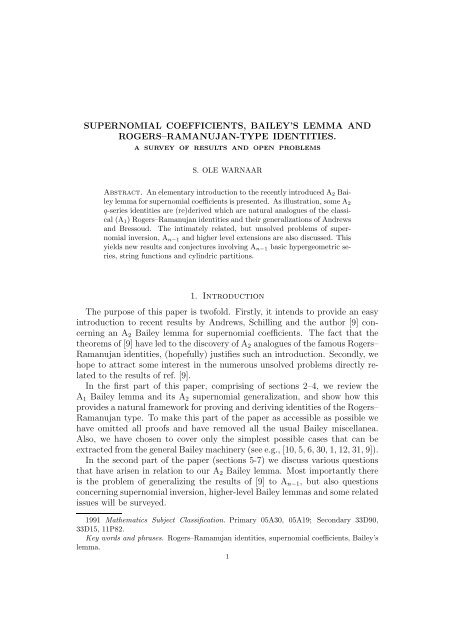
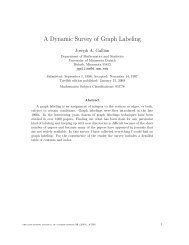


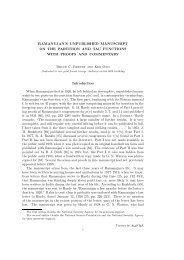
![(.,t ] and [s, .) , where [s,t ] = {s' GT; s ¤ s' ¤ t} , (.,t ] = {s' GT; s' ¤ t} and ...](https://img.yumpu.com/43303393/1/184x260/t-and-s-where-st-s-gt-s-a-s-a-t-t-s-gt-s-a-t-and-.jpg?quality=85)


